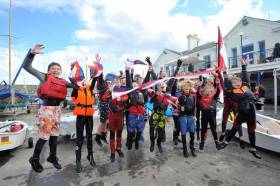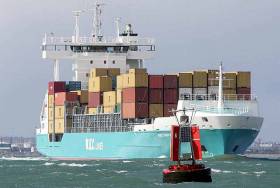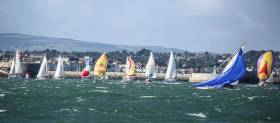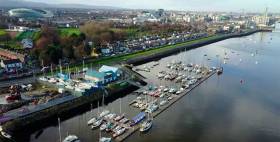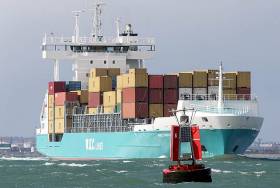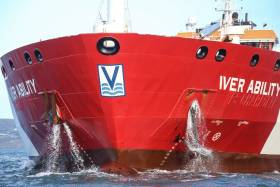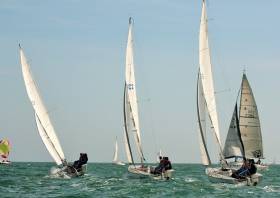Displaying items by tag: Dublin Bay
National Yacht Club Junior Sailors Celebrate Links to Olympic Silver Medal & America’s Cup
A very special Golden Jubilee coming up in May provides links to an Irish Olympic Sailing Silver Medal, the Fireball World Championship, and the America’s Cup. W M Nixon finds the widest connections go even further than that to include a pioneering world voyage.
It was in May 1967 that the irrepressible Carmel Winkelmann oversaw the first results of a junior sailing initiative at the National Yacht Cub, her home club in Dun Laoghaire. It became a movement which went on which to have nationwide and worldwide ramifications, so much so that within Ireland we’re looking at an unbroken line in Irish sailing which is continued through the club which currently holds the title of ISA Training Centre of the Year, which for 2017 is Foynes Yacht Club on the Shannon Estuary.
That a successful club at the heart of the Atlantic seaboard can trace an almost magic thread back to something which happened at a club on Dublin Bay a long time ago is quite a story in itself. Particularly when the Atlantic seaboard club itself is imbued, as Foynes is, with the spirit of legendary circumnavigator Conor O’Brien. However, when the story is shaping up to continue with the Golden Jubilee as the latest chapter, it gives us an opportunity both to celebrate, and take stock of what it has all meant.
 Foynes Yacht Club, heirs to an Irish tradition of junior sail training which was first formalized by the National Yacht Club 50 years ago. At the Irish Sailing Awards ceremony when Foynes were announced as winners of the ISA Training Centre of the Year Award were (left to right) Simon McGibney (Foynes Senior Instructor), Sailor of the year and Olympic Silver Medallist Annalise Murphy of the National Yacht Club, Elaine O’Mahoney (Foynes Sailing Academy Manager), Pat Finucane (Sailing Academy Principal) and Conor Dillon (Instructor). In a club which is imbued with the spirit of world-girdling Foynes sailor Conor O’Brien, it’s particularly appropriate that Conor Dillon’s sailing CV includes winning the Two-Handed division in the Round Ireland Race, sailing with his father Derek Dillon on a 34-footer. Photo: Inpho
Foynes Yacht Club, heirs to an Irish tradition of junior sail training which was first formalized by the National Yacht Club 50 years ago. At the Irish Sailing Awards ceremony when Foynes were announced as winners of the ISA Training Centre of the Year Award were (left to right) Simon McGibney (Foynes Senior Instructor), Sailor of the year and Olympic Silver Medallist Annalise Murphy of the National Yacht Club, Elaine O’Mahoney (Foynes Sailing Academy Manager), Pat Finucane (Sailing Academy Principal) and Conor Dillon (Instructor). In a club which is imbued with the spirit of world-girdling Foynes sailor Conor O’Brien, it’s particularly appropriate that Conor Dillon’s sailing CV includes winning the Two-Handed division in the Round Ireland Race, sailing with his father Derek Dillon on a 34-footer. Photo: Inpho
But business first. Anyone who has ever taken part in the Junior Training Programme at the National Yacht Club is hereby alerted – if you don’t know already – that on the evening and night of Saturday May 20th, there will be a very special celebration at the clubhouse. The organisers Carmel Winkelmann and Ann Kirwan are particularly keen to trace those who have moved away, but would find much nostalgic pleasure with the meeting of old friends by returning on this day of days. So if that applies to you, or you know anyone to whom it does, please make contact with the key club administrator whom everyone refers to as “Oonagh at the National”, the proper line of contact being [email protected], tel 01-280 5725.
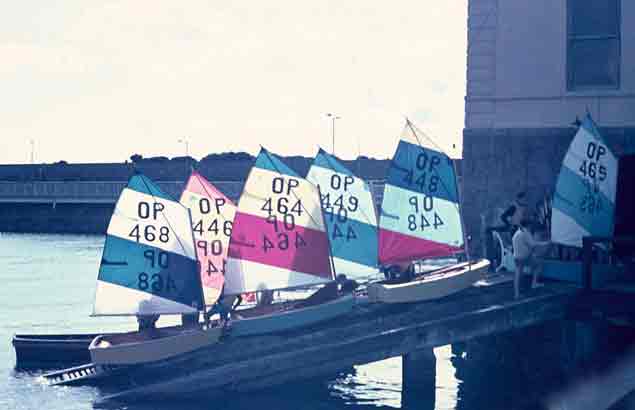 Bright morning of Optimism. The National Yacht Club slipway in 1967, long before the days of an extensive front-of-club platform, with the new dinghies of the Optimist Class being launched out of the cramped boathouse under the club, and down a steep and often very crowded slipway
Bright morning of Optimism. The National Yacht Club slipway in 1967, long before the days of an extensive front-of-club platform, with the new dinghies of the Optimist Class being launched out of the cramped boathouse under the club, and down a steep and often very crowded slipway
To grasp the significance of what is being celebrated, please try to visualize the National Yacht Club as it was fifty years ago. The building itself, standing directly in the harbour, has the air of a fishing lodge in the West of Ireland on its seaward side, and a hint of neo-classicism when seen from the town. But in the early 1960s it was very limited in its shoreside facilites for sailing dinghies. There was a boathouse entered through fine granite arches under the clubhouse itself, but to use it, masts needed to be lowered. It was served by a very steep and easily-crowded slip, while there was access to another slip on the east side of the cub which served a small area where dinghies could be stored. But while there was space for the established classes of Fireflies and some IDRA 14s, some room was also needed for the small tenders for larger yachts moored in the harbour, while the racing keelboats were served by club launches which might be substantial dinghies driven by vintage Seagull outboards.
The concept of a proper dinghy park was still only in its infancy, relatively speaking, for craft such as Dun Laoghaire’s Firefly and IDRA fleets which had been active since the late 1940s. Thus if anyone had a centreboard boat which could reasonably be expected to lie to moorings, she was obliged to do so, and the fleet of small craft lying off the club included the 17ft Mermaids and the 14ft Water Wags.
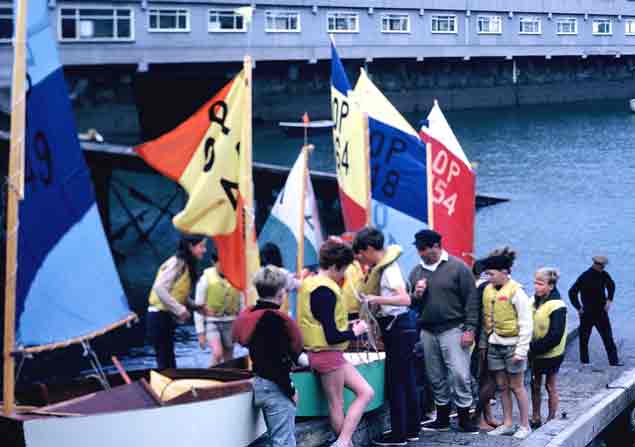 It could get very crowded on that steep slipway. Paddy Kirwan at the centre of a group making do with limited facilities
It could get very crowded on that steep slipway. Paddy Kirwan at the centre of a group making do with limited facilities
To compound the space problems afloat and ashore, during the 1960s the area in the southeast part of Dun Laoghaire Harbour off the National Yacht Club was the focal point for the cross-channel ferry berths. The railway-system serving Mailboat with its emphasis on foot passengers continued to use the Carlisle Pier to the west of the club, but the East Pier was known for a period as the Car Ferry Pier as a busy new roll-on roll-off terminal, which admittedly always had a temporary look about it, had been constructed there to accommodate the new trend in cross-channel travel.
Thus not only was anyone sailing a dinghy from shore at the National YC dong so out of decidedly limited facilities, but they immediately sailed into an area cluttered with a collection of moored boats of all shapes and sizes, and that in turn was set in an area which might have ferry ships berthed close by, or manoeuvring on either side.
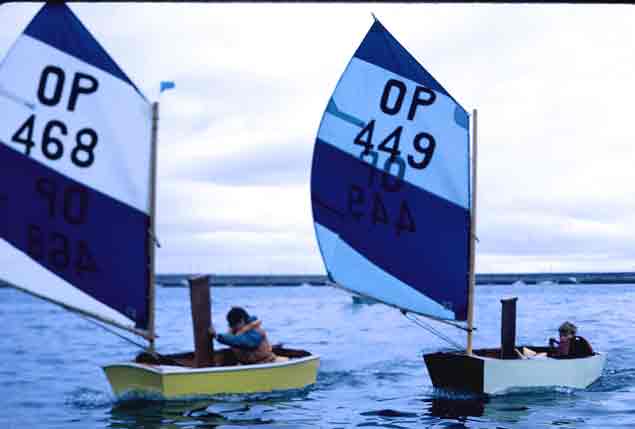 Learning curve. Gina Duffy and John Lavery on a close run in 1967. The latter has won many major championships, including the Fireball Worlds in 1995
Learning curve. Gina Duffy and John Lavery on a close run in 1967. The latter has won many major championships, including the Fireball Worlds in 1995
The comparisons with today’s National Yacht Club with its spacious platform facing out over a much clearer harbour area, and beside it an installation of convenient berthing pontoons, could not be greater. But back in the 1960s, an equally important change was happening – there was a complete re-appraisal of what the most junior sailors really needed in boats and instruction to get the best from the sport.
For sure there were the Fireflies, but in terms of lower age limit they were really aimed at adolescents on the cusp of rapidly growing youth. The other available classes were even more adult-oriented. In fact, the underlying problem was that children going sailing were treated as miniature adults who would somehow pick up the skills of the game through a sort of osmosis, whereas for a crucial period of their lives they would have most benefitted from being treated as a different species, with different boats to meet their needs.
Yet even here, adult views dominated. The grown-ups thought that young people’s boats should at least look like small yachts. Thus a dinghy which was promoted for children by several clubs was the 11ft Yachting World Cartop Heron, which had originally been conceived as a DIY-build which could fit on the roof-rack of the average family car, and was designed with a gunter rig such that all its spars could be stowed within the boat.
It had some good ideas, and with a pretty sheer it fulfilled the adult expectation of what a miniature yacht should look like. But it was surprisingly heavy for its avowed rooftop requirement – you’d have needed a weight-trained family to get it on the car roof. And anyway, it was too large for really small kids who genuinely had the sailing bug.
 The southeast corner of Dun Laoghaire Harbour was very different in 1967, with the East Pier re-designated as the Car Ferry Pier. Yet despite the limitations, the Optimist class quickly caught on after its introduction in 1967
The southeast corner of Dun Laoghaire Harbour was very different in 1967, with the East Pier re-designated as the Car Ferry Pier. Yet despite the limitations, the Optimist class quickly caught on after its introduction in 1967
So a revolutionary approach was needed, and it came thanks to one of the National YC’s international sailing stars, Johnny Hooper. He had achieved Ireland’s first Olympic Race win with Peter Gray in the Flying Dutchman in the 1960 Rome Olympics when the sailing was at Naples. But as an FD campaign towards the 1984 Olympics was prohibitively expensive with the venue in Japan, he returned to his first love of International 505 Racing, and it was at a big 505 championship in Scandinavia in 1965 or thereabouts that he first became aware of the game-changing possibilities of the Optimist for junior sailing.
Scandinavia being rightly renowned for the elegance of its yacht, it speaks volume for the versatility of the Florida-originating Optimist, the “simple little boxboat that sails surprisingly well”, that Scandinavia should lead the movement towards a world body for a boat which, whatever the traditionalists might think, the kids were clearly loving. Founded 1965, the International Optimist Dinghy Association (IODA) had Viggo Jacobsen of Denmark as its first President with his wife Edith as Secretary, and in that same year Johnny Hooper set about introducing the idea of the Optimist to Ireland.
Now if some ordinary Joe had happened to by impressed by an Optimist at some foreign location, and had even brought one home to persuade his fellow sailors that they were looking at the future, the idea probably would have fallen very flat indeed.
But that’s not the Hooper way. Instead, from his highly respected position he quietly targeted fellow National Yacht Club members who were themselves active sailors, but also had children who would benefit from the Optimist experience, and in time a group emerged which was to include initially Johnny Hooper with his wife Bernie giving the longterm involvement, Peter Gray, Paddy & Barbara Kirwan , Don Douglas, Franz & Carmel Winkelmann, Michael McGrath, Arthur Lavery and several others, many of whom had reasonable DIY skills and could see the possibility of building an Optimist in the basement of their Dun Laoghaire homes without too much disruption of the household. By the Autumn of 1966, the project was under way.
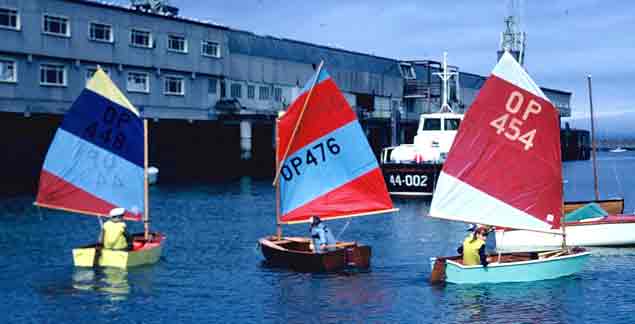 The first of the new fleet sails. Paddy Boyd (left) Ann Kirwan (centre) and Vivienne Lavery right) getting to know their boats
The first of the new fleet sails. Paddy Boyd (left) Ann Kirwan (centre) and Vivienne Lavery right) getting to know their boats
While Johnny Hooper had introduced the idea, he stood back from its continuing implementation, for the Hooper modus operandi was to give an idea enough strength to soon have wings of its own. That certainly happened in the National Yacht Club, for very quickly a manageably small committee was in being, and the formidable Carmel Winkelmann became its secretary. The NYC Junior Programme became her baby, and it always has since been seen as such, even though the number of people involved in administering the programme over the fifty years, as the NYC facilities have expanded and developed to meet the needs of a modern membership, will now run into the hundreds.
In fact, properly organized junior sailing with boats specifically designed for young people’s needs is now so central to Irish sailing that it takes a huge leap of the imagination to visualize the scene as the first small group of National Yacht Club Optimist Dinghies – most of them locally-built either by amateurs or professonals – began to emerge in May 1967 with numbers increasing as each weekend passed. New they may have been, but they reflected their era, with a public Blessing of the Boats outside the Brindley household as a new batch of boats appeared.
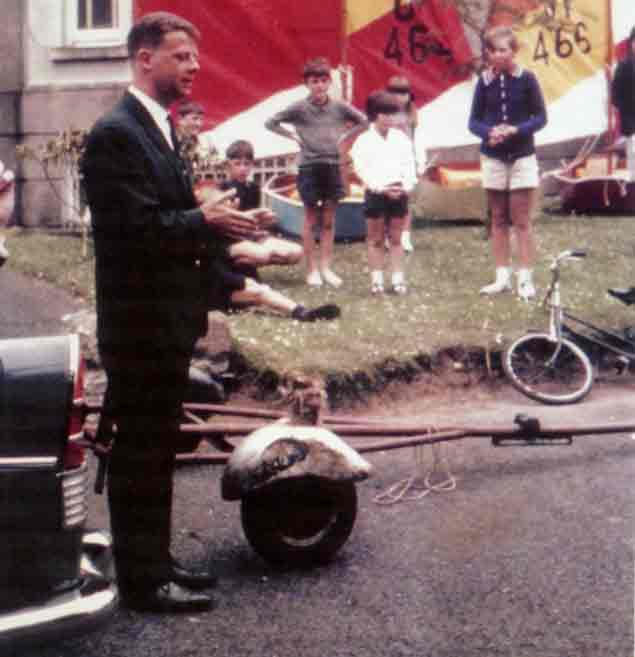 Olympic sailor Johnny Hooper speaking at the Blessing of the Boats as a new batch of home-built Optimists awaits transfer to the National’s limited space.
Olympic sailor Johnny Hooper speaking at the Blessing of the Boats as a new batch of home-built Optimists awaits transfer to the National’s limited space.
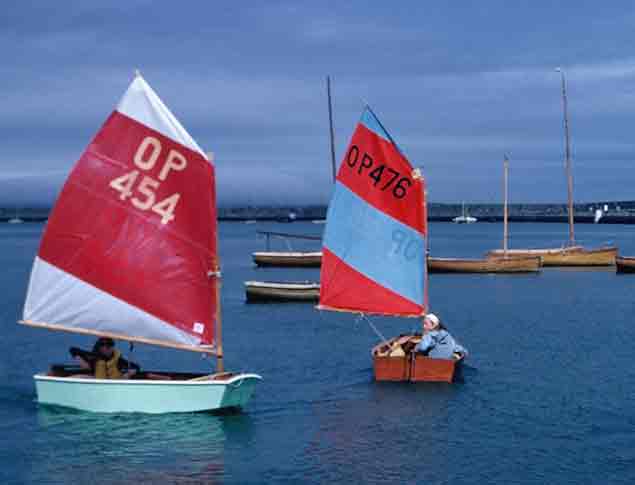 Dun Laoghaire was a different place in those days, with Water Wags and Mermaids expected to lie to mooring. Vivienne Lavery and Ann Kirwan testing their skills with the new Optimists – Ann’s boat (476) was one of the few professionally-built in the first batch of Optimists, she was created by the legendary Skee Gray
Dun Laoghaire was a different place in those days, with Water Wags and Mermaids expected to lie to mooring. Vivienne Lavery and Ann Kirwan testing their skills with the new Optimists – Ann’s boat (476) was one of the few professionally-built in the first batch of Optimists, she was created by the legendary Skee Gray
But though most young sailors in theory had his or her own boat, before anything approaching full fleet numbers was approached they’d a habit of letting anyone sail some boat or other in the early stages, so much so that although Ann Kirwan was part of it from a very early stage, she admits that even she can’t claim total accuracy when identifying the helm of a known boat.
 Going abroad......the new Dun Laoghaire Optimists make their debut at Bray Regatta: Paul, Adam and Lucy Winkelmann with Paddy Kirwan putting in his renowned act as a South American Air Marshall at Bray Sailing Club.
Going abroad......the new Dun Laoghaire Optimists make their debut at Bray Regatta: Paul, Adam and Lucy Winkelmann with Paddy Kirwan putting in his renowned act as a South American Air Marshall at Bray Sailing Club.
This habit of inter-changing sailors became even more marked in that first year when the early class discovered that the most useful base for their day-time sailing was the little-used Irish Lights service barge moored in the western part of the harbour. Over there, NYC Optimist sailors found much clearer sailing water, and they were well away from the comings and goings of the two cross-channel ferries off their home club, not to mention excessive parental control. In effect, the barge became their day-time base, and they ate their packed lunches aboard it while deciding who would take which boat for the first stage of the afternoon’s sailing. Fifty years down the line, we might well wonder if the Commissioners of Irish Lights are aware of the key role their humble barge played in launching Ireland’s Junior Training Programme.....
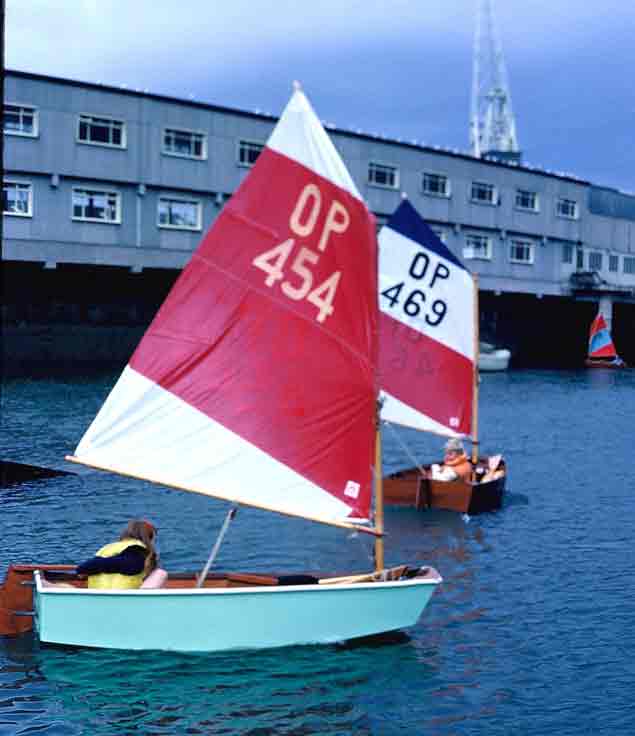 Vivienne Lavery and David Ryan getting away from the slip.
Vivienne Lavery and David Ryan getting away from the slip.
Once launched in its viable form in 1967, there was no stopping it, and the names which have emerged just from the National’s junior programme alone (for virtually all clubs now have one) take us over an extraordinary range, and up to the heights of Olympic participation, the winning of major world dinghy championships and associations with the America’s Cup.
It’s Johnny Smullen who provides the latter. The California-based Johnny Smullen in San Diego is now of world stature in anything to do with yacht and boat-building or indeed in marine construction generally, and his talent has been recognized at the highest level as he has worked on major projects for the very demanding Dennis Conner, aka Mr America’s Cup.
Johnny will have inherited his feeling for classics from his father Cass, a great sailor who was such an enthusiast for the Dublin Bay 21s in their original rather spectacular gaff-rigged form that when the class contemplated changing to a more easily-handled and convenient Bermudan rig in 1963, Cass claimed that he could easily rig a gaff-rigged DB 21 in 15 minutes flat. And that included setting the jackyard topsail to perfection. So he brought a DB 21 close into the clubhouse (as you could in those days), and in front of a drink-sipping crowd of observers on the verandah, he did the job within 15 minutes. But they still went ahead and converted to Bermudan rig.
Son Johnny meanwhile was enlisted in the NYC Junior Programme as soon as he reached he lower age limit, and when the 40th Anniversary was being celebrated back in 2007, he sent on his memoirs which well capture the flavour of it all:
San Diego, 17th May 2007
The way I saw it.
I am eight years old and my parents are wondering what to do with me for the summer, it went something like this: “Get him out from under our feet”. I was equally happy to stay at home and play in the back garden, invent stuff and dream up ways to frighten my sisters. Chasing them with worms was a good one.
I was enrolled in the adventure of my life.
At first I was lead to believe it was going to be a fun thing with the opportunity to meet new people and friends, maybe making me more sociable as I was quiet child in a world of my own. I bought into this and showed up for the first day. It was great, lots of people all different shapes and sizes, so there we were all sitting around playing with stuff and one-upping on how my father is better than yours, especially at snooker. The chatter fell silent when along came this very tall white-haired lady with an incredibly loud voice. It was at this point I became suspicious as I had just watched Paths of Glory and A Bridge Too Far, I had seen how the enemy rounded up people and put them in trucks and brought to places, unfriendly places.....
We arrived at Sandycove harbour where we were lined up on the pier. I though this was it, we were then forced to line up at the steps and walk down into the freezing water fully clothed and flail around, there were guards (instructors we were led to believe) everywhere, and just to make sure the torture was effective they made us hold our heads under water for 30 minutes, well 30 seconds, but it felt like minutes. Then we were all forced to walk back to the NYC where our fate was to be determined. Freezing and scared, I was cursing my family and wondering what I had done to them.
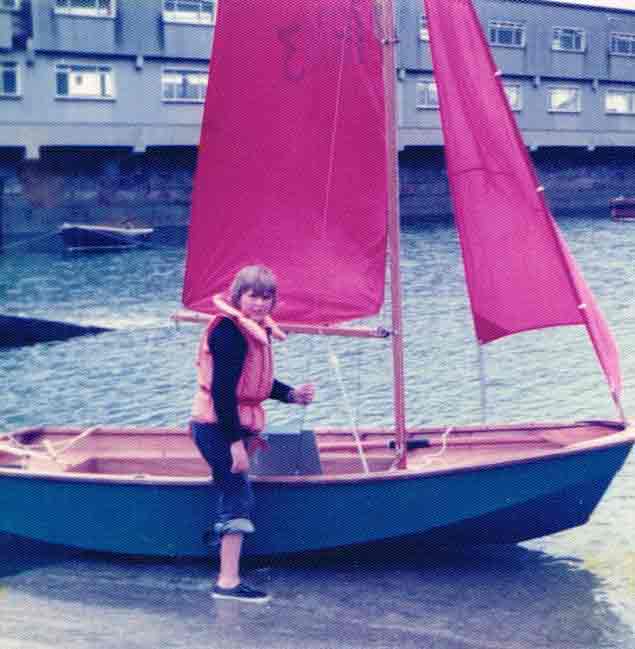 He survived.....eventually Johnny Smullen became a keen Mirror dinghy sailor, but he was pessimistic enough to call his boat Splinter
He survived.....eventually Johnny Smullen became a keen Mirror dinghy sailor, but he was pessimistic enough to call his boat Splinter
We arrived back at Camp NYC and were lined up and made to wear large cumbersome protective coats, some were yellow, purple, some orange, I guessed they were labelling us, something to do with our religion. Some of these jackets had large protective collars probably to help protect us from the beatings to come, I thought. Our names were branded onto the “Life Jackets” as I started to call them, knowing they would play a key role in our protection.
We were divided into groups and lead away by the guards into this large damp room with arches and a dank smell of cotton, hemp and mould. This was where we were to remain for all the rainy days to be brain-washed, they started by teaching us knots. I was convinced this was going to be how to tie the very knot that would be the doom of us, I compared it to carrying the cross of Calvary. I decided then to be really bad at it in the hopes that one of my knots would slip open and I could dash to my freedom. We also had to jump up, and hand-over-hand along the light blue steel beam that ran across the dark room, this was to make our arms really strong, they had a plan for strong arms – I will tell you about that a little later.
Food consisted of a march up to Wimpeys for a spice burger and chips all drowned in vinegar to disguise the taste, if there was good behaviour we got to go to the Miami Café. The day was long (except Thursdays when we had to get out early) and after a week in Boot Camp we were all tired and weary. What had I done to my family to deserve this?
The second week came along and we were introduced to the ships, rather large wooden craft resembling a landing craft with the flat bow (I was always looking for the hinges). This is where the strong arms came into. We were grouped into six per team, and the guards waited until low tide when we had to carry the ship down a rickety wooden slip (there’s a reason for calling it a slip). Upon its surface there were large wooden rollers but we were forbidden to use those rollers, and to make sure they filed a fat spot on the rollers, deeming them useless. We picked up the incredible heavy boat, all six of us, one on each corner holding a knee, and two in the middle by the oar locks. Later I was to learn the place to be was up at the bow (by the door), it was lightest. I was adapting to this cruel camp. As we descended down to the icy water again fully clothed, we came across a bright green pungent slime. I had what I thought were special sailing shoes, but as soon as I touched the slime I was down. Down hard. The guards started yelling, I knew I had to get up quickly....remember Calvary!....We reached the bottom and stopped, the guards yelled again and made us wade right into the icy deep, still fully clothed. With the landing craft now floating, we had to master manoeuvring, the craft were lined up alongside the slippy slip, that’s the reason they call it a..................
I stepped on the gunwhale. Now at this point I did not understand the physics like I do today, and when you apply a load to any point of the gunwhale of a flat-bottomed craft two things will happen (once only). The opposing gunwhale will come up as you travel down, and because I am as tall as the craft is wide, somewhere in the middle he two surfaces will meet, your face and the opposing gunwhale. After the initial shock, the second shock comes from the icy cold water. Then I found out what the large collar was for as the guards hauled me out of the abyss semi-conscious. Once inside the craft, we were grouped into two and handed oars. Let the games begin.....
After a week of rowing and shipping oars and coming alongside we were all adapting well to boating, there’s nothing to it. Just as we are enjoying ourselves, we are reminded that this is a work camp with launch and retrieval exercise twice a day. The launch and retrieval is carefully timed at 6 and 12 hours intervals to make sure it was low tide and we’d the longest slimiest walk up the rickety slips, observed closely by the guards from the window of the snooker room glaring down at us. Boating is turning out to be challenging but fun, and the new friends are all pitching together to eventually plan an assault on the guards to free ourselves.
The third week came along and there were large wooden poles with white canvas and a stick with notches cut out of it, why on earth did they have to make it harder? It was perfectly simple with the clean decks and oars and oar locks, now the boats are so heavy with this rig up, my bow lifting position is not that smart as we carry down the slip with the sail pressed hard against my face. After countless days of theory brainwashing in the damp room, we have to pass a few tests to prove worthy to sail, if called upon, out to the US Aircraft Carrier John F Kennedy anchored out in Dublin Bay. The first test was to take the stick with the notches and stretch out the canvas and hook onto a rope loop, without falling over this was harder than carrying the feckin’ boat, the second was to line up two pins while hanging over the transom full of chips and spice burgers. If it had hair....
Most of us mastered that task after a few tries, and it wasn’t long before we were sailing out to the sterns of the ferry Hibernia or Cambria, whichever was in port at the time. This went on for a few weeks and as we settled into the routine it got easier as we went on.
During the time in the damp boathouse, usually when it was blowing dogs off chains outside and while I was trying to get the batteries out of the loudhailer, I noticed a beautiful varnished clinker planked boat, it was almost new, and a very wise man was looking after it. This Man was tough as the rivets holding it together and knew everything about the seas. I knew if I paid attention he would help get me through the summer, he did and he is almost responsible for what I do today. Thank you Jack!
The discipline of Boot Camp had turned us into great sailors, great card players, snooker players....it wasn’t until the third stage we found flagons. But not on the night of May 17th 1975, I was at home doing my homework that night....
Ah.....the memories, I hope I have stirred a few, it was the most wonderful time of my life and I wish I was there to get drunk with all of you and play cards till the wee hours, but meanwhile thanks
To Carmel, thank you very much; I always have my lifejacket.
To Jack Brennan, I am always thinking of you up there, and thanks for teaching me how to tie my shoelaces.
To all the instructors Paul, Ann, Jimmy, I never believed the story of the rabbit and the tree, but thanks anyway
And to all my dear family and friends
Lots of love, Johnny Smullen
PS It was me that stuck the coke bottle in the cannon at the front of the club....
 Johnny Smullen and Dennis Conner inspect the hull of the 1925-built Cotton Blossom
Johnny Smullen and Dennis Conner inspect the hull of the 1925-built Cotton Blossom
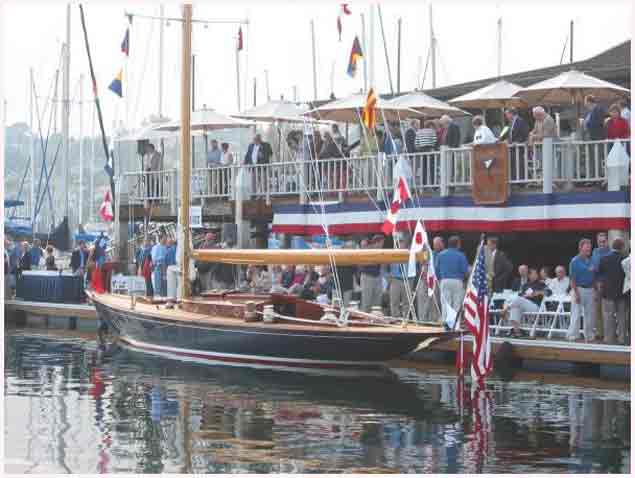 Cotton Blossom II after restoration by Johnny Smullen
Cotton Blossom II after restoration by Johnny Smullen
Inspired by Jack Brennan and other master craftsmen, Johnny has gone on to become a shipwright of such skill from his base in San Diego, California, that he in turn inspires others, one of his most famous projects being the complete restoration of the 49ft Q Class sloop Cotton Blossom II of 1925 vintage.
When a complete restoration is contemplated, Johnny doesn’t mess about. The word is that when he and Dennis turned up to finalise the deal on Cotton Blossom and bring her back to San Diego, they found the previous owners sorry enough to see her go, and rather proud of the style in which they’d maintained her. But after they’d gone to sort the details with the new owner, they went to take a last look at the boat. It’s said they found that Johnny had already delivered his opinion on the existing rig by cutting the shrouds and stays at the deck with bolt-croppers, and cutting the old mast off at deck level with a chainsaw.
Maybe that’s an apocryphal Johnny Smullen from taking delivery of another boat. Yet when you see Cotton Blossom in her restored form, it’s clear what Johnny says should indeed be Holy Writ. This is a project of world standard. But what’s even more remarkable is that despite everything the Sailing Boot Camp at the NYC might have inflicted on him all those year ago, Johnny’s love of boats and sailing is such that he has his own personal sweet classic, the lovely 36ft International One Design Altair. She’s sailed as often as possible, and though he can’t make it back to Dun Laoghaire next month for the Golden Jubilee as there’s very major project under way, Altair will be racing with the San Diego classics under the National Yacht Club burgee.
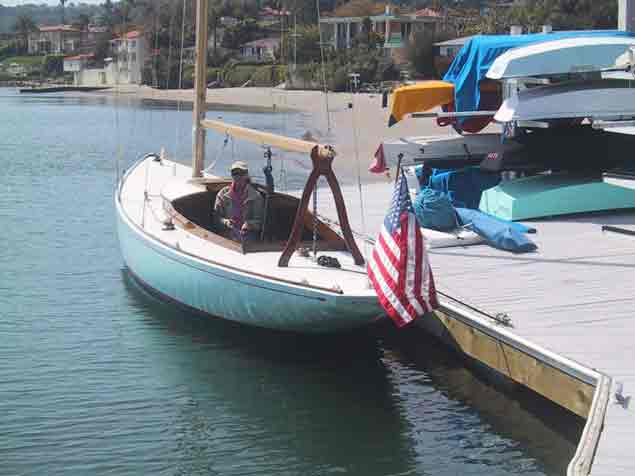 Johnny Smullen’s own pet boat Altair reveals his abiding love of sailing.
Johnny Smullen’s own pet boat Altair reveals his abiding love of sailing.
John Lavery’s father Arthur was another of those pioneering Optimist dads back in the late 1960s, and John and his sister Vivienne were both in that first batch of trainee sailors. He ended up winning championships in more classes then you could quickly count, but the peak of it all came in September 1995 when he and David O’Brien of this parish won the Fireball Worlds in Dublin Bay.
In fact, the graduates from 50 years of a junior training programme at the National YC can be found in successful positions in many boat classes in many places, but it is the club’s outgoing attitude to those who wish to learn to sail which deservedly provided its most outstanding success. A long time ago a Mrs MacAleavey, a widow with no sailing connections, was looking for a club which would make her increasingly boat-mad daughter Cathy – who had recently bought a clapped-out 420 – feel encouraged in any way to learn to sail. Despite the fact that it was still in process of recovering from a fire in the clubhouse, the NYC showed itself the most welcoming along the Dun Laoghaire waterfront, so much so that Mrs McAleavey felt sufficiently encouraged to buy her daughter a new 420, and that in turn led on eventually to Cathy representing Ireland in the women’s 470 in the 1988 Olympics.
The three children she had with husband Con Murphy went on to get their introduction to sailing through the National YC’s junior programme, and daughter Annalise emerged with the talent and the burning ambition which resulted in a heart-breaking fourth at the 2012 Olympics in the Women’s Laser Radial when a medal had seemid almost certainly within her grasp. But memories of that were entirely laid to rest with the Silver Medal in the 2016 Olympics Rio after a difficult final race in which the lone sailor seemed to stay as cool as you please, while the nation at home watched with bated breath.
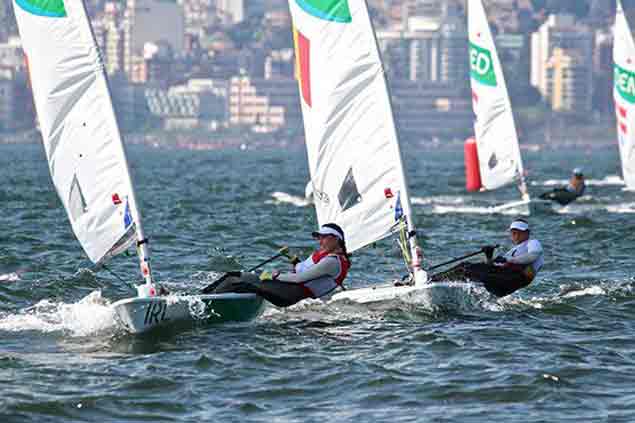 The medal-winning moment as Annalise Murphy crosses the finish line in Rio to win Silver.
The medal-winning moment as Annalise Murphy crosses the finish line in Rio to win Silver.
That it was ultimately a very personal achievement is something respected by her club, and they claim to have done nothing more than provide the first steps on the pathway, and a general spirit of encouragement. But nevertheless the success is all of a piece with the Golden Jubilee which will be celebrated on May 20th, and Carmel Winkelmann continues in her mission of providing a background of training for young sailors of all types, whether they aim only to be a competitive club sailor, or whether they aim for the ultimate heights.
Thus one of her projects in recent years was to find real support for young Finn Lynch, who had reached that difficult stage of being a top junior sailor, yet still had to find his feet as an adult. Thanks to support raised by Carmel, he became Ireland’s representative in the Men’s Lasers at Rio despite going through the final stages of the selection with a training injury recovery problem which may have had an adverse effect on his performance in as the youngest sailor in Rio, aged just 20.
Whether or not he would have been better off not being in Rio at all is neither here nor there. When you’re 20, four years can seem an appallingly long time. The Tokyo Olympics in 2020 must have seeemed aeons away for a young sailor who had shown many flashes of real talent. It was better for him to be in Rio while learning a lot, rather than kicking his heels in frustration in some dead end. And when he needed material help to see through the campaign, it was Carmel Winkelmann who was there to make to ensure that support was available. That will be something else for celebration on May 20th.
 Carmel Winkelmann and Finn Lynch at the National Yacht Club, June 2016. Photo W M Nixon
Carmel Winkelmann and Finn Lynch at the National Yacht Club, June 2016. Photo W M Nixon
Dublin Port Records 4.2% Growth in Q1, Announces €11.7m Dividend
Dublin Port Company today published trade statistics for the first quarter of 2017 showing continued strong growth of 4.2% after last year’s record throughput of 34.9 million gross tonnes.
Dublin Port also announced that it will pay a dividend to the State of €11.7m in 2017, bringing the aggregate dividend payment since 2007 to €101.2m. The dividend follows a strong financial performance in 2016, during which turnover grew by 5.1% to €81.6m and EBITDA grew by 8.8% to €53.6m.
This strong performance comes after growth of 25% in the four years to 2016, with the high growth trend continuing into the first quarter of 2017.
Total throughput for the three months to the end of March was 8.7 million gross tonnes with 1,843 ship arrivals, equivalent to 20 ships each day. Both imports and exports grew strongly with imports ahead by 3.3% and exports even more strongly at 5.5%.
Summary of Quarter 1 2017 Trade Statistics
|
Gross tonnes |
Quarter 1 2017 |
Quarter 1 2016 |
% change |
|
Imports |
5.1m |
5.0m |
3.3% |
|
Exports |
3.6m |
3.4m |
5.5% |
|
Total |
8.7m |
8.4m |
4.2% |
|
|
Quarter 1 2017 |
Quarter 1 2016 |
% change |
|
Ro-Ro units |
238,831 |
221,758 |
7.7% |
|
Lo-Lo TEU |
163,086 |
163,002 |
0.1% |
|
Trade vehicles |
32,459 |
31,862 |
1.9% |
|
Quarter 1 2017 |
Quarter 1 2016 |
% change |
|
|
Passengers |
270,171 |
297,762 |
-9.3% |
|
Tourist vehicles |
78,874 |
82,958 |
-4.9% |
The largest parts of Dublin Port’s business are Ro-Ro freight trailers and Lo-Lo containers. Ro-Ro grew by 7.7% with 238,831 units in the first three months. Lo-Lo containers grew by 0.1% to 163,086 TEU.
Tourist volumes were down in the first quarter of 2017 due, primarily, to Easter falling this year in April. Last year it fell in March.
Eamonn O’Reilly, Chief Executive, Dublin Port Company, said:
“Having seen growth of 25% in the four years to last December, 2017 has started strongly with growth of 4.2% in the first quarter.
“Growth at this level was the norm over decades before the economic crash after 2007. What we are seeing in Dublin Port’s volumes is entirely consistent with the strong recovery evident in the domestic economy in recent years.
“Long-term growth requires additional capacity and we have a ten year €600m capital investment programme well underway to make sure that Dublin Port can continue to meet demand between now and 2040.
“This capital programme is part of our long term Masterplan to 2040 which we are currently reviewing to ensure it remains up to date and relevant. We will publish a revised Masterplan in the summer. Our next step then will be to begin planning additional capital development projects which can take up to 20 years to deliver from concept to completion.
“Alongside our large planned expenditure on capital projects, it is important that we continue to pay a dividend to the State and I am delighted that we are in a position this year to pay an €11.7m dividend, equivalent to 30% of last year’s profits. Dublin Port Company had a strong year in 2016 with turnover growth of 5.1% to €81.6m and increased profit after tax of 7.3% to €39.0m.”
ISORA & DBSC Ready to Kick off The Summer Sailing Season
The annual 'lift–in' of yachts at the four waterfront yacht clubs at Dun Laoghaire Harbour last weekend means one thing: there is just two weeks until the first races of the summer sailing season on Dublin Bay.
Up to 300 boats ranging from ten–foot dinghies right up to 50–foot ocean-going keelboats will compete in a variety of separate series and regattas.
The first of which is the ISORA offshore series of the year. It begins on Saturday, April 22nd. The following Tuesday, April 25th, the Sherry Fitzgerald sponsored Dubin Bay Sailing Club (DBSC) season gets underway. Read Commodore Chris Moore's season preview here.
ISORA sees action on both sides of the Irish Sea. Firstly there is a coastal race from Pwllheli sponsored by Global, forming part of the Global displays Welsh coastal series, and the full ISORA series and simultaneously a coastal race from Dun Laoghaire to Wicklow, sponsored by Viking Marine forming part of the RAYC coastal series and of course the full ISORA series.
Both races will be tracked by Yellow brick trackers.
Dun Laoghaire Ready to Host Ireland’s Biggest Sailing Fixture
The 2017 Volvo Dun Laoghaire Regatta (VDLR) which is now established as the biggest sailing event in Ireland was launched this evening at the Maritime Museum in Dun Laoghaire. This biennial fixture which is organised by the four Dun Laoghaire waterfront yacht clubs (the Dun Laoghaire Motor Yacht Club (DMYC), the National Yacht Club (NYC), the Royal Irish Yacht Club (RIYC) and the Royal St George Yacht Club (RSGYC) will take place across four days in early July and attracts yachts from all four coasts of Ireland and from England, Scotland, Wales, Northern Ireland and the Isle of Man, and more locally from all the four Dun Laoghaire based yacht clubs.
Speaking at the launch event, David Lovegrove, President, Irish Sailing Association (ISA) said “The VDLR is now firmly established in Ireland’s major sporting calendar and is the biggest participant sporting event in the country, after the city marathons. We are also proud that the VDLR continues to grow and build upon Ireland's international reputation as a quality sports and sailing destination and cements Ireland's reputation as a location for a major international regatta. In addition, local area businesses will benefit considerably from the influx of visitors as they enjoy the superb sailing action in Dublin Bay and a fantastic array of family oriented activities that have been set up on shore.”
The key classes of yachts that will attract the most attention and competition during the Regatta will be the IRC Class 0, Class 1, Class 2, Class 3 and the IRC Offshore Class, who all, already have strong noteworthy entries. In addition, other ‘one design’ classes will include the Beneteau 31.7s, Beneteau 211, Sigma 33, Ruffian 23s, Dragon, RS Elite and the Shipman 28. The dinghy classes will include the GP14, Wayfarer, Squib, Mermaid, Flying Fifteen, Fireball, and single-handed Lasers and Moths.
Most notably this year there will be a Classics division in VDLR 2017 comprising a ‘Kingstown 200’ Anniversary Cup as part of the Dun Laoghaire Harbour Bicentenary Festival from July 6th to 9th 2017.
A monument on the Dún Laoghaire sea front commemorates the first stone of the eastern pier laid by his Excellency Charles Earl Whitworth Lord Lieutenant General and General Governor of Ireland on 31st May 1817, and the visit of King George IV in 1821 (Asylum Harbour of Dunleary was named Kingstown in 1821 and renamed Dun Laoghaire in 1920).
Also speaking at the launch event, Tim Goodbody, Chairman, VDLR 2017 said “The VDLR owes its prominence in European sailing events to a number of factors. One of the core attributes to attracting so many entrants is that it is one of the least expensive sailing events in Europe, thanks to generous sponsorship and support, so providing great value for money for all in the lovely waters of Dublin Bay” .
We also have more than 300 volunteers who give their time and energy to ensure the regatta runs smoothly, as well as the active cooperation of local area businesses and the Dun Laoghaire-Rathdown County Council. And of course the support from the thousands of visitors who come to watch the spectacle and take part in all the family oriented activities in and around Dun Laoghaire.”
“In addition the Regatta brings a significant amount to the local economy. Using the Irish tourism multiplier, the average expenditure per competitor will be €60 per day which for 2,500 competitors will be €150,000 per day and €600,000 for the four day event” added Tim Goodbody.
The VDLR is kindly supported by
• Volvo Car Ireland in partnership with Spirit Motor Group (Title sponsor)
• Dun Laoghaire Rathdown County Council
• Dun Laoghaire Harbour Company
• Failte Ireland
• Collen Construction – New Sponsor
• Helly Hansen
• Royal Marine Hotel
• Bretzel Bakery
• Dubarry
DBSC Spring Chicken Sailing Series Extended to March 26
Handicaps and start times (downloadable below) have been issued for this Sunday's DBSC Spring Chicken series racing. Also issued is an amendment to the Sailing Instructions to extend the series after recent cancellations due to bad weather on Dublin Bay.
The Rathfarnham Ford sponsored series will now run to 26th March 2017 inclusive, taking in the St. Patrick's weekend on Sunday 19th March too.
According to Dun Laoghaire Marina forecast the weather for Sunday is staying unsettled. Rain is likely, may be persistent for several hours. Cloudy skies overall. Some brighter spells. Visibility poor in rain, but at times good. Sea state moderate. Winds (low confidence) at 0900 W 15-20kt and W 20-25kt on the Irish Sea.
Fears of Another Cancellation for DBSC Spring Chicken Cruiser Racing as Forecast Shows Strong Westerlies
After only one race sailed in three weeks, DBSC Spring Chicken organisers are making plans to extend the Dun Laoghaire series if this weekend also falls foul of the strong wind forecast.
Handicaps and Starts for next Sunday's Dublin Bay race are downloadable below.
The DBSC committee are considering extending to 19th & 26th March in order to complete the six race series and a decision is expected next week.
Dublin Port: Poolbeg To Lose Its Pontoons? Sandymount To Lose Its Strand?
This is Public Consultation Week for the First Review of Dublin Port’s Development Masterplan 2012-2040, and with a 28-year timespan involved, some of the more remote yet very possible proposals will still seem at the very least far-fetched - and at worst outrageous - to residents and harbour users most directly affected writes W M Nixon.
You’ll need to get your skates on if you’re going to see how the port is presenting its proposals in the neighbourhoods most directly involved, as the Clontarf session today (Monday 13th February) in Scoil Ui Chonaill GAA was due to conclude at 8.0pm. Tomorrow being St Valentine’s Day, everyone will be otherwise occupied as Dublin is a a city of incurable romantics, but the show resumes on Wednesday 15th February from 2.0pm to 8.0pm at the Sean O’Casey Community Centre, St Mary’s Road, East Wall Road, Dublin 3.
However, it’s the concluding show on Thursday 16th February, again from 2.0pm to 8.0pm, which is likely to attract most sparks, as it’s in Clanna Gael Fontenoy GAA Club, Sean Moore Road, Ringsend, Dublin 4, and it’s the Dublin communities of Ringsend, Irishtown and Sandymount – all in Dublin 4 - which would see some of the more far-fetched proposals having greatest impact.
From a visit to the Clontarf presentation today (Monday) it seems that while the harbour’s development seawards is now being handled in a way which has assuaged the worst fears of Clontarf residents, it is Dublin Port’s determination to maintain a strong and growing presence south of the river which could permanently change life for people in Ringsend and Sandymount.
With the two parts of the port connected only by the East Link Lifting Bridge, this is an almost permanent traffic bottleneck, so it’s not surprising that a proposal expecting early implementation is a new bridge immediately east of the East Link.
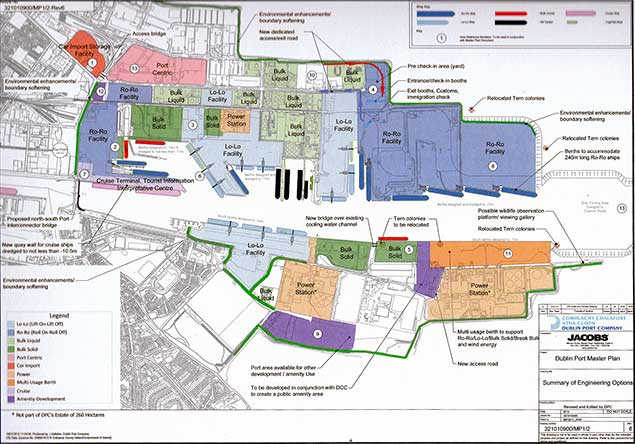 Connections between the north and south parts of the port are always under strain, and an early proposal was the installation of a second bridge immediately eastward of the present East Link Bridge
Connections between the north and south parts of the port are always under strain, and an early proposal was the installation of a second bridge immediately eastward of the present East Link Bridge
At the moment this parallel bridge seems to be proposed as a link exclusively for port traffic. But if that is the case then new road capacity has to be provided from the new bridge eastward to Poolbeg Roundabout, so an alternative scenario is that the new bridge be paired with the existing East Link to provide a dual carriageway, which in turn will be continued to the Poolbeg Roundabout.
Providing such a dual carriageway will inevitably take a chunk out of the space at present used by Poolbeg Yacht & Boat Club both on the land and in their marina too. So instead of a compact marina clustered at the club, one variation of the plan shows an elongated marina running virtually the whole way to the new bridge immediately seaward of the northern lane of a the new dual carriageway.
However, while this may lessen the East Link bottleneck, most of the traffic using the East Link is not port-related anyway. They’re just people deluded by the notion that they’re taking the quickest way from the North City – and particularly the airport – to the vast affluent swathes of the south county. They arrive smoothly at the East Link via the Port Tunnel, and now if the East Link to Poolbeg Roundabout section become effectively a mini-motorway, they’ll be further deluded until they find themselves back in old-fashioned traffic jams as they try to make their way towards Sandymount Strand.
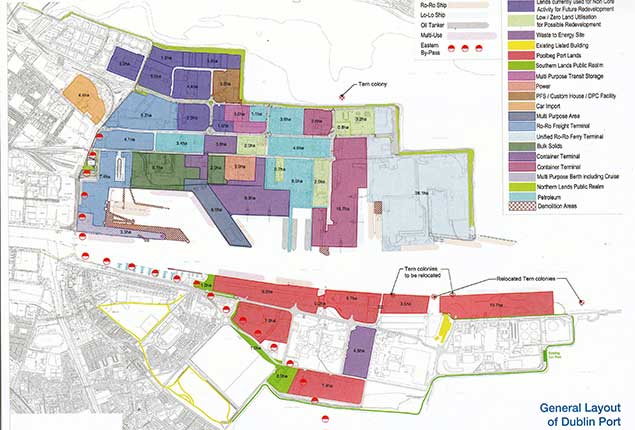 Hints of how the port might be. A new fixed bridge has been built across the mouth of the Dodder on the South Bank immediately upriver of the Eastlink, thereby cutting off access to the Grand Canal Basin for all but “canal boats”, while the line of red-and-white dots is the suggested route of the Eastern By-pass, which seems to be sent off from the Poolbeg Peninsula into the wide open spaces of Sandymount Strand.
Hints of how the port might be. A new fixed bridge has been built across the mouth of the Dodder on the South Bank immediately upriver of the Eastlink, thereby cutting off access to the Grand Canal Basin for all but “canal boats”, while the line of red-and-white dots is the suggested route of the Eastern By-pass, which seems to be sent off from the Poolbeg Peninsula into the wide open spaces of Sandymount Strand.
So the old monster which just won’t go away, the Eastern Bypass, raises its head again in the proposals relating to the more distant future, though “distant” is only relative – 28 years is no time at all. Be that as it may, the cheapest option for an Eastern By-pass is a motorway-standard dual carriageway along Sandymount Strand, upon the completion of which, the next discussion will be where it re-joins the city’s road system.
But that’s an argument for another day which may not be necessary if another line of thought is taken, to which we’ll come in a minute. But right now, whatever happens, there’s no doubting that the cosy setup at Poolbeg, with a friendly club with a strong sense of community, and it all handy to the city, is under threat.
In fact, sometimes when you see ships manoeuvring within feet of the delicate marina structure in a real breeze of wind, you can’t help but think that you are watching a YouTube “Best Ship Disasters” vid in the making, and that Poolbeg Marina’s continued existence is a little miracle.
 It can be quite thought-provoking to see ships being manoeuvred in a breeze of wind within a stone’s throw of Poolbeg Marina. Photo: W M Nixon
It can be quite thought-provoking to see ships being manoeuvred in a breeze of wind within a stone’s throw of Poolbeg Marina. Photo: W M Nixon
So the Poolbeg contingent are planning to be there in strength on Thursday to see for themselves just what the future might hold, and among other things they’ll see confirmation that a bus-lane-and-pedestrian bridge is highly likely across the mouth of the Dodder, thereby cutting off access to the Grand Canal Basin for vessels with masts or even just exceptional top hamper – the only reassurance I could get was that “canal boats” will have sufficient clearance.
As for the Eastern Bypass, if the cheapo version along the beach is built, then Sandymount will indeed have lost its strand. At the moment, the little coastal road is something you can walk across at any point, and the seashore seems very accessible. But as soon as you get eastward of Merrion Gates, the railway is defining most of the shoreline, and the sense of the sea being accessible is no longer so apparent – who ever talks of Booterstown Beach?
A motorway along the beach is every bit as much of a barrier as a railway, so it would be the end of Sandymount Strand as thousands know and love it. But anyway, if such a road were built, it would only deliver people further along the line into another jam. To make sense, it would have to go all the way to the nearest part of the M50/M11 linkup, which is somewhere about Leopardstown. Yet there’s just no way a raw new motorway is going to be built across this unrivalled area of prime real estate. However, north of the river the Port Tunnel is merrily working away, doing its work so well we almost forget it exists. Yet it seemed impossibly grandiose at the time it was first proposed.
A Ringsend to Leopardstown Tunnel would be about three times as long, and it would need at least two interchanges built into it to make logistical sense. But it is certainly well within the scope of fairly basic tunneling technology. And up in Arranmore in Donegal, there’s inherited tunneling expertise from the time of building the Channel Tunnel between England and France. The Arranmore economy would find the Ringsend-Leopardstown Tunnel a very nice little earner, thank you. And with some clever planning, it could leave the communities of Ringsend, Irishtown and Sandymount largely intact.
Dublin Port Announces First Review of Masterplan 2012-2040
Dublin Port’s Masterplan 2012-2040, a framework to guide the future development and operation of Dublin Port, makes provision for periodic reviews. This ensures that the Masterplan reflects changing circumstances such as developments in policies governing planning, national transport, the environment and the economy.
Among the areas to be examined during the consultation are:
- The proposed development of a Unified Ferry Terminal for the Port’s main ferry operators incorporating all facilities required for the State including immigration, customs, security and other border inspection functions.
- The proposed removal of non-core activities from the Port and the redevelopment of up to 22 hectares of lands.
- The proposed reduction over time of the 30 hectares of Port lands occupied by petroleum importation facilities.
- The proposed development and redevelopment of up to 43 hectares of Port lands on the Poolbeg Peninsula including 17 hectares within the Poolbeg West SDZ.
- The proposed development of the 44 hectare Dublin Inland Port adjacent to Dublin Airport to provide facilities for non-core but port-related activities.
Since it was first published in 2012, there have been a number of significant developments which have prompted a review of the Masterplan now. These include:
- Sustained high levels of growth
- Commencement of the Alexandra Basin Redevelopment (ABR) Project and other major port infrastructure projects
- Policy developments at a national, regional and local level
- International developments including Brexit and the possible introduction of customs and other security controls in Dublin Port.

Public Consultation: A Consultation Paper has been prepared to help inform the public consultation, which runs until Tuesday 7th March 2017. Dublin Port is inviting submissions from all those with an interest in the future development of the Port. Public Information Days will take place from 2-8pm in local community venues, where members of the public can meet with representatives from Dublin Port Company in person, learn more about the review and make their views known:
- 13th February: Scoil Uí Chonaill GAA Club, 95 Clontarf Road, Clontarf, Dublin 3
- 15th February: Seán O’Casey Community Centre, St. Mary’s Road, East Wall, Dublin 3
- 16th February: Clanna Gael Fontenoy GAA Club, Sean Moore Road, Ringsend, Dublin 4
The Masterplan Review 2017 will be published in the summer to ensure that the Masterplan will continue to form the basis of future developments at Dublin Port, as trade volumes grow.
Eamonn O’Reilly, Chief Executive of Dublin Port Company, said:
“Dublin Port’s volumes are now 13% or 4.0m gross tonnes higher than they were at the peak of the boom in 2007. When we originally launched our Masterplan five years ago, we assumed an average annual growth rate of 2.5% over the 30 years to 2040. We now believe we need to increase this growth assumption to 3.3%. Under this revised assumption, the Port’s volumes would increase by 265% to 77m gross tonnes over the 30 years to 2040.
“It is prudent that we respond to changing circumstances as they impact on the Port’s operations and capacity to grow. That is why we are reviewing our Masterplan and, as part of this review, I would encourage people to take the opportunity to participate in the consultation over the coming weeks.
“The focus of the review will be on how best we can use our lands to increase the throughput capacity of the Port. DPC believes that the Port can be developed to cater for anticipated volumes through to 2040 within the Port’s existing footprint and without significant major infill works. This will require the maximum utilisation of our brownfield sites and adjacent river berthage.
“The implementation of the next phase of the Masterplan will continue to focus on achieving proper planning and sustainable development through the continued redevelopment of the brownfield sites within Dublin Port’s existing footprint.”
2016 Trade Figures & Growth: Dublin Port’s volumes have increased by 25% in just four years, underpinning the need for the Company’s major capital investment programme to provide essential capacity for future growth. The growth is shown as follows:
| Year | Growth |
| 2013 | +3.0% |
| 2014 | +7.0% |
| 2015 | +6.4% |
| 2016 | +6.3% |
| 2013 to 2016 | +24.7% |
The 6.3% increase in overall volumes in 2016 was relatively evenly spread between imports (which were up +6.1%) and exports (+6.7%).
| Gross tonnes | 2016 | 2015 | % |
| Imports | 20.7m | 19.6m | 6.1% |
| Exports | 14.2m | 13.3m | 6.7% |
| Total | 34.9m | 32.9m | 6.3% |
There was strong growth in the unitised freight modes with Ro-Ro ahead by +7.6% to 944,531 units in the year. Lo-Lo grew even more strongly at +8.1% to 663,732 TEU.
New trade vehicles through Dublin Port increased by +2.0% to 104,185 in the year.
Finally, on the passenger side of Dublin Port’s business, ferry passenger numbers grew by
+0.9% to 1.8m.
| 2016 | 2015 | % | |
| Ro-Ro units | 944,531 | 877,826 | 7.6% |
| Lo-Lo TEU | 663,732 | 613,864 | 8.1% |
| Trade vehicles | 104,185 | 102,149 | 2.0% |
| Passengers | 1,814,089 | 1,797,691 | 0.9% |
| Tourist vehicles | 505,482 | 500,628 | 1.0% |
Long Stay Red Tanker 'Iver Ability' Departs Dublin Bay for Dutch Port
Iver Ability, the red hulled ship, anchored in Dublin Bay since August, left its six–month mooring yesterday, bound for the Dutch Port of Delfzijl.
The long term anchorage of the ship followed a 'reaction' onboard the Asphalt/Bitumen tanker during her transport of Bitumen into Dublin Port this summer.
The ship cut a lonely sight over Christmas 2016, as 'discussions with charterers' for a port of discharge for the vessel’s cargo continued.
While at anchorage in Dublin, the ship was fully operational with all seafarers performing normal duties and standard crew changes taking place, according to the ship's managers.
Corporate Sailing League Launched on Dublin Bay
Do you tell your friends or work colleagues all about your sailing adventures? Do they ask when you will bring them sailing or racing? Kenneth Rumball of the Irish National Sailing School thinks he may have the answer for you. The Irish National Sailing and Powerboat School is launching its all new Corporate Sailing League on Dublin Bay, the aim of which is to provide intercompany competition and networking through sailboat racing as a team on board a proven 1720 Sportsboat.
Our fleet of six 1720s are all identical having this year gone through a considerable refit. Therefore, the winning boat will be the one sailed to the best meaning teamwork is key to sucess. Our hope is that a keen competent sailor from a company will sell the idea to four of his colleagues to create a team of five to go racing against other companies and teams. For those teams that need some extra help, we will run a full training evening with the boats and if required provide a competent skipper/instructor as part of the team.
Sailing has proven globally how the sport can encourage teamwork amongst teams on the same craft while also providing great competition especially in one design boats which leads to great networking opportunities once back ashore after racing.
A series of short races will take place over five Tuesday evenings throughout the summer, 23rd May, 20th June, 18th July, 22nd August, 19th September. It is not necessary for the same team members or leaders to be present on each evening just make sure your company is represented! Racing will start at 1930 giving teams plenty of time to get out of the city to go sailing.
Après Sail: Growing and expanding business is hugely dependant on connections, forging new relationships, maintaining and building on existing contacts. Sailing is used worldwide by many of the elite companies in all sectors for this purpose. With many managing directors, CEOs and top businessmen sailing for pleasure and to keep business contacts alive. We see our new product essential for this purpose allowing up and coming associates in growing companies getting a step ahead to form new relationships. There will be a meal or BBQ after every evenings racing to facilitate this.
How does a company benefit? Any company can benefit hugely from this program by giving their employees the chance to form new business contacts and connections while also enhancing teambuilding on a thoroughbred race boat. In addition for every company that signs up to our program, we will get signs made with your company’s logo proudly displayed on our boats to give maximum visibility to a wide range of decision makers who sail regularly on Dublin Bay.
The cost of the programme is €1,500 per team


























